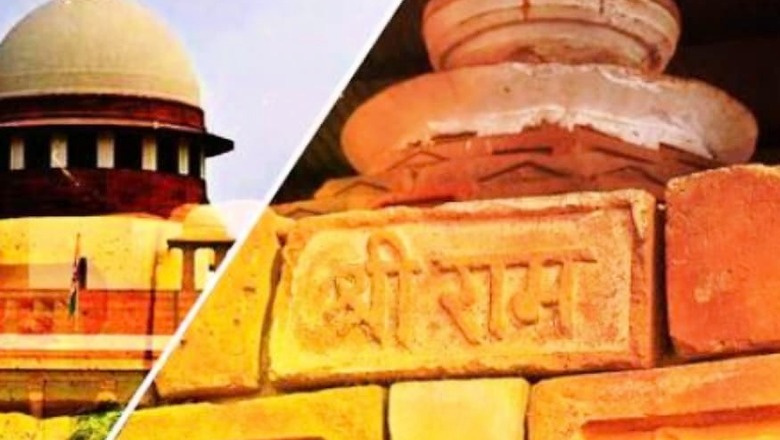
views
The politics of Nepal has been bewildering and rather messy this week. The country’s Prime Minister KP Sharma Oli has irked many a devout Hindu Indians by claiming that Ram — contrary to the Indian belief — was Nepali, and the site of his birth, Ayodhya, lies in the Nepalese territory. In doing so, Oli seems to have irked many of his own country men and women as well. Specifically, he claims that Ram’s birthplace is in Thori, not far from the city of Birgunj. He has accused New Delhi of ‘cultural encroachment’ and it appears that the Nepali foreign ministry has sort to soften and make his remarks more acceptable by suggesting that more research needs to be done in the cultural history of the Ramayana, and now Nepali archaeologists are reported to be planning studies and excavations.
For a millennia, Ramayana and the names of its characters and the places associated with them have been a lexicon (/vocabulary) of power. Oli’s remark is less about the fact that Ram might have been Nepalese and appears to be more of a covert attempt to assert cultural and economic independence and different alliances, at a time when the power dynamics of the region are shifting. But Oli has been slammed. His future looks uncertain. The BJP leaders have accused him of playing with ‘people’s faith’ and Nepali politicians claim he has “lost lost the moral and political basis” to rule.
This isn’t the first time a political leader has sought to gain traction — or assert power — by claiming kinship or association with Ram and his birthplace. Across millennia stories, names and places of the Ramayana have been used and reused, and cropped up in places thousands of kilometers away, to produce and reflect great political changes. In the fourteenth century, an epidemic forced King U Thong of Lavo Kingdom to shift his capital and build a new capital city of Ayutthaya, a city in Thailand, and to establish a kingdom there. U Thong came from a city and a capital that also had associations with the Ramayana — Lavo Kingdom’s capital was Lopburi — that is, a derivation of ‘Lavapuri’ — the city of Lava. This isn’t the only city or kingdom to be named after Ram’s son. Lahore in Pakistan and Laos, the South East Asian kingdom, also share this distinction.
But U Thong not only referenced the birthplace of Ram in his new capital, he went a step further than Oli and gave himself a new title — Ramathibodi I, that is, “Lord Ram.” This title remains in use today — even though a different dynasty now rules Thailand, the Chakri dynasty, which displaced the rulers of Ayutthaya. But the Chakri kings, monarchs of a Buddhist country, continued the tradition of adopting Rama as a name and title. Case in point: the present king of Thailand, known as Maha Vajiralongkorn when he was crown prince. Today, he is King Rama X.
The Thai and Laotians were not the only ones who adopted names and associations with the epic for a powerful effect. The Vijaynagara empire, on the banks of river Pampa (Hampi comes from Pampa) then known as river Pampa, and associated with the river of the same name in the Ramayanaand Kishkinda, the site where Ram met Hanuman and Sugriva. The footprints of Hanuman are found all across South and South East Asia — in Hindu, Muslim and Buddhist countries — in Lepakshi, Indonesia, Thailand and Malaysia and countless other places.
Why does the Ramayana and its places crop up across millennia in different places and still in the twentieth century? I’d like to claim that is to the enduring power of a story — but the idea of kingship associated with Ram, the conflation of divine right and power, makes his name, and the places associated with his story powerful. The Ramayana also for those who have been dispossessed is a powerful story — the story of an exile, dispossessed prince, who is victorious and full of heroic, self-sacrificing virtue, who places the words of his people and his parents over his own desires has shaped our culture, our values and left us with culturally ingrained templates of leadership. Leaders who tap into this thus adopt, for themselves, the same mantle of power and idea of divine kingship.
The Ramayana is not the only epic that does this —cultures and kings in the past — from the Rashtrkutas of Karnataka, to Airlangga, a ruler in East Java, to the rulers of the Khmer Empire, drew on the names, associations and myths of the Mahabharata. The ancient rulers of Java, in present-day Indonesia, declared themselves to be God-kings, incarnations of Vishnu and Shiva — and Suharto, the long-ruling president of Indonesia and a Muslim, saw himself, and was seen, as a ruler who wielded mystical, divine power — perhaps a testament to the legacy of the Javanese God-kings. The usage of names and sacred geographies as a means to assert and certify power is nothing new. But it still seems to have a powerful effect, in the case of Ayodhya. The idea of Ayodhya, and it’s sacredness, has certainly been an influential perhaps kingmaking factor across millennia and across the continent, and even in our country, in recent times.
It surprises us, who live here in India and assume that the epic is solely our cultural property and is Hindu that the Ramayana has travelled outside of India, and influenced Muslim and Buddhist cultures and political systems. Yogyakarta, on the island of Java, in Indonesia, the most populous Muslim country, is a city also named after Ayodhya.
The Ramayana went and continues to be viral. It has travelled and it has shaped the languages of power, in South and South East Asia, and it has travelled even outside of these places, through the spread of the Indian diaspora , to countries as far away as Fiji, Trinidad and Guyana, where Ram Leelas still take place, and giant effigies of Ravana are still burnt on Dussehra.
For the younger generation reading this article, a more recent manifestation of the viral effect of the Ramayana is (believe it or not) the Japanese anime phenomenon Dragon Ball Z. Does Goku of Dragon Ball Z have anything to do with Ramayana? It seems he does. He is a character created from the Chinese legends of Sun Wu Kong, the great money king of Chinese folklore, who, in turn, shares an interesting similarity with Hanuman — both are monkey Gods. Some scholars believe that stories of Hanuman travelling, on the silk route, carried by traders and travellers, spreading far and wide merged with other myths to create Sun Wu Kong.
It seems that where people have travelled, they have taken these stories with them, and these stories took root on foreign soil, shaping cultures, power systems and communities, and birthing in turn new iterations, retellings and stories. And this continues to happen. This leaves us with the question: Is there a real Ayodhya? Is Ayodhya in India or in Nepal or could it even be in Thailand?
Ayodhya seems less to be a physical place and to me, both Ram and Ayodhya are best described as ideas, acts of imagination, (an idea that came from reading the work of Sheldon Pollock, who is a scholar that the Hindutva followers don’t like very much), carried in the shape of our story, in beliefs, customs, festivals and rituals that allow for the possibilities of power, new starts, independence, across time. Using these words thus asserts political legitimacy and divine leadership and taps into the power of belief.
Conjuring Ayodhya, seems to have backfired for Oli in this instance, but it seems to have worked for the BJP in this country, and it seems to have worked for King U Thong, back in the fourteenth century. But Oli’s words are a continuing testament to how a story, which has spawned innumerable versions and storytelling traditions, has fashioned our culture, our politics and our ideas of self, and in doing so, has birthed — and will continue to birth — even more iterations and retellings.














Comments
0 comment